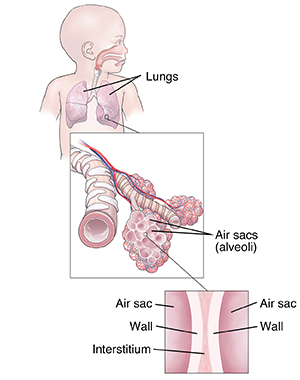Understanding Pulmonary Interstitial Emphysema (PIE)
Pulmonary interstitial emphysema (PIE) is a condition that can affect newborn babies. It occurs when air gets trapped in the tissue outside the tubes and air sacs of the lungs. It often affects babies who use a machine to help them breathe (ventilator) or a CPAP (continuous positive airway pressure) device. PIE is fairly common in neonatal intensive care units (NICUs). It often affects newborn babies with respiratory distress syndrome and low-weight babies who need a ventilator. These infants often have a lung problem that is caused by preterm birth. PIE may affect one or both lungs.
How the lungs work
When you breathe, air travels in through your mouth through a series of tubes to your lungs. At the ends of these tubes are tiny air sacs (alveoli). This is where gases get exchanged. Here, the lungs deliver oxygen to the blood. And they release carbon dioxide, a waste product. The oxygen then travels through the blood to all the organs of your body.

Normally, air is only found in these respiratory tubes or tiny sacs of the lungs. But in some cases, air can escape into the nearby tissue around the tiny sacs. This tissue is called the interstitium. This can happen if the wall of an air sac breaks open. If enough air leaks out, this can cause problems with breathing and blood flow. PIE is one type of pulmonary air leak syndrome.
PIE is classified by how long it lasts:
PIE may also be widespread or localized:
What causes PIE?
Air can leak from an air sac when the sac is overstretched. This may happen when air gets trapped in the sac. Or it may happen when the air is not spread evenly in the lungs.
Being on a ventilator may cause PIE. During artificial ventilation, a ventilator puts air pressure on the air sacs of your child’s lungs. This helps your child breathe by opening closed-off lung sacs. But in some cases, this extra pressure can create a leak in an air sac. Lung disease makes it more likely that these air leaks will happen. Lung disease may be caused by immature lungs or other health conditions.
Most cases of PIE happen in newborns who have other lung problems. It is common in babies who need to be on a ventilator. Careful adjustment of ventilator settings may help reduce your child’s risk for PIE. Conditions that can increase the risk for PIE include:
-
Preterm birth or low birth weight, which often leads to respiratory disease
-
The lungs don't develop correctly (pulmonary hypoplasia)
-
Breathing in the first intestinal discharge (meconium) at birth
-
A lung infection (pneumonia)
-
Very fast breathing right after birth (transient tachypnea of the newborn)
Signs of PIE
Signs of PIE often appear within 4 days of birth. Mild PIE may have no signs. More severe PIE may cause signs of breathing trouble, such as:
-
Grunting or other signs of trouble breathing
-
Fast breathing
-
Pale appearance
-
Lips or other parts of the body look blue (cyanosis), purple, or gray because of low oxygen in the blood
Diagnosing PIE
You may be asked about your child’s and your health history. This may include information before, during, and after birth. Your child will have a physical exam. Their heart and lungs will be checked. Blood tests will be done to look for signs of low levels of oxygen and high levels of carbon dioxide.
Your child may also have an imaging test, such as a chest X-ray or a chest CT scan. Leaked air will often appear on both of these imaging tests.